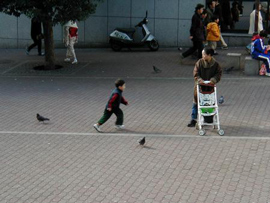Learn About Japan > Work and Workplaces in Japan > Women > Low Birth Rate and Working Women

|

Women
- Introduction of Female Suffrage
- Tokuju (Special Order) Boom and Female Workers
- Increase of Female Employees
- Popularity of American Style Fashion and Western Dressmaking
- Part-time Female Workers
- Women and Agriculture
- Ama (Female Diver)
- Marriage Retirement and Retirement Ages for Men and Women
- Office Ladies (OL)
- Dual Tracks in Female Occupations: Ippan Shoku (Non-Career Track) and Sōgō Shoku (Career Track)
- Laws Regarding Working Women
- Sexual Harassment
- Low Birth Rate and Working Women
- Separate Surnames for Married Couples
- Female dominant occupations
- “Mighty” Women: Police and the Military Self Defense Force
|

A child runs by himself in a park in Japan.
Photo Courtesy of Jeff Laitila, www.sushicam.com.
Low Birth Rate and Working Women
Every year, fewer and fewer children are born in Japan. The average lifetime birthrate among Japanese women has been declining since the mid-1970s, and reached 1.57 in 1989. Although the government has developed policies such as the “Angel Plan” to promote childbearing, the birthrate has continued to drop and reached 1.36 in 2000. An average lifetime birthrate of 2.1 is needed in order to maintain the current population size. With the current low birthrate, it is predicted that Japan’s population will be reduced by 20% in the next fifty years. One of the reasons for this trend toward fewer children is the difficulty women face in raising children while working. In the past among Japanese farm families, grandparents often took care of children while the parents worked but present-day urban Japan consist mostly of nuclear family households, which cannot count on help from grandparents. Moreover, there is a great shortage of daycare facilities where working mothers can leave children. Even when mothers are fortunate enough to utilize a daycare center, the hours of service are limited. Many companies allow childcare leave or reduced work hours for childcare for mothers but not for fathers. Click CHART to see the shift in the birthrate in Japan.
|
|
|
| Download Podcast in
English
| Japanese
|
|
Document |
Audio-Video |
Chart |
Picture |
Map
|
|

